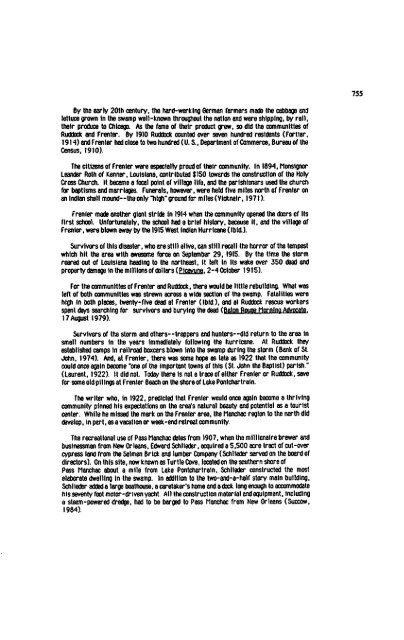Full document / COSOC-W-86-002 - the National Sea Grant Library
Full document / COSOC-W-86-002 - the National Sea Grant Library
Full document / COSOC-W-86-002 - the National Sea Grant Library
- TAGS
- nsgl.gso.uri.edu
Create successful ePaper yourself
Turn your PDF publications into a flip-book with our unique Google optimized e-Paper software.
By <strong>the</strong> early 20th century, <strong>the</strong> hard-workingGerman farmers made<strong>the</strong> cebbaga and<br />
lettuce grown in <strong>the</strong> swamp well-known throughout<strong>the</strong> nation andwere shipping, by rail,<br />
<strong>the</strong>ir produce to Chicago. As <strong>the</strong> fame of <strong>the</strong>ir product grew, so did <strong>the</strong> communities of<br />
Ruddock and Frenler. By 1910 Ruddock counted over seven hundredresidents (Fortier.<br />
1914) and Frenler had close to twohundred (U.S., Department ofCommerce, Bureau of <strong>the</strong><br />
Census, 1910).<br />
The citizens of Frenler were especially proudof <strong>the</strong>ir community. In l894,Monstgnor<br />
Leander Rothof Kenner. Louisiana, contributed$150 towards <strong>the</strong> constructionof <strong>the</strong> Holy<br />
CrossChurch. It became a focal pointof village life, and<strong>the</strong> parishioners used<strong>the</strong> church<br />
for baptismsendmarriages. Funerals, however, were held five miles northof Frenler on<br />
an Indian shell mound—tha only"hltf" ground for miles (Vicknelr, 1971).<br />
Frenlermade ano<strong>the</strong>r giantstride In 1914 when<strong>the</strong> community opened <strong>the</strong> doors of Its<br />
first school. Unfortunately, <strong>the</strong> school hada brief history, because it. and <strong>the</strong> village of<br />
Frenler,wereblownaway by <strong>the</strong> 1915 West Indian Hurricane (Ibid).<br />
Survivors of this disaster, whoere still alive, canstill recall <strong>the</strong> horror of <strong>the</strong> tempest<br />
which hit <strong>the</strong> area with awesome force on September 29,1915. By <strong>the</strong> time <strong>the</strong> storm<br />
roaredout of Louisiana heading to <strong>the</strong> nor<strong>the</strong>ast. It left In Its wake over 350 dead end<br />
property damage tn <strong>the</strong>millions ofdollars (PJc&une., 2-4 October 1915).<br />
For<strong>the</strong> communities of Frenler andRuddock, <strong>the</strong>re wouldbe little rebuilding. What was<br />
left of both communities was strewn across a wide section of <strong>the</strong> swamp. Fatalities were<br />
high In both places, twenty-five dead at Frenler (Ibid), andal Ruddock rescue workers<br />
spent days searching for survivorsand burying <strong>the</strong>dead (Baton Roups Morning Advocate.<br />
17August 1979).<br />
Survivors of <strong>the</strong> storm endo<strong>the</strong>rs--trappers endhunters—didreturn to <strong>the</strong> area In<br />
small numbers In <strong>the</strong> years Immediately following <strong>the</strong> hurricane. At Ruddock <strong>the</strong>y<br />
established camps In railroad boxcars blown Into <strong>the</strong>swamp during <strong>the</strong>storm (Bank of St.<br />
John, 1974). And,at Frenler, <strong>the</strong>re was some hopeas late as 1922 that <strong>the</strong> community<br />
could once again become "one of <strong>the</strong> Important towns of this (St. John <strong>the</strong>Baptist) parish."<br />
(Laurent, 1922). It didnot. Today <strong>the</strong>re Is nota traceof ei<strong>the</strong>r Frenler or Ruddock, save<br />
forsomeoldpllIngs at Frenler Beach on<strong>the</strong>shoreof Lake Pontchartrain.<br />
Thewriter who, in 1922. predicted that Frenler would onceagain become a thriving<br />
community pinned his expectations on <strong>the</strong> area'snatural beautyendpotential as a tourist<br />
center. While he missed<strong>the</strong> markon<strong>the</strong> Frenler area,<strong>the</strong> Manchac region to <strong>the</strong> northdid<br />
develop, tn part, as avacationor week-end retreat community.<br />
The recreational use of Pass Manchac dates from 1907. when <strong>the</strong> millionaire brewer and<br />
businessman from NewOrleans. Edward Schlieder, acquireda 5,500 acre tract of cut-over<br />
cypress land from <strong>the</strong> Salmen Brick endlumberCompany (Schlleder servedon<strong>the</strong> board of<br />
directors). Onthis site, nowknownas Turtle Cove, located on <strong>the</strong> sou<strong>the</strong>rnshore of<br />
Pass Manchac about a mile from Lake Pontchartrain, Schlleder constructed <strong>the</strong> most<br />
elaborate dwelling In <strong>the</strong> swamp. In addition to <strong>the</strong> two-and-a-half story main building.<br />
Schllederadded a largeboathouse, a caretaker'shomeandacock longenough to accommodate<br />
his seventy foot motor-drivenyacht All <strong>the</strong>construction material andequipment, including<br />
a steam-powered dredge, had to be barged to Pass Manchac from New Orleans (Succow,<br />
1984).<br />
755















